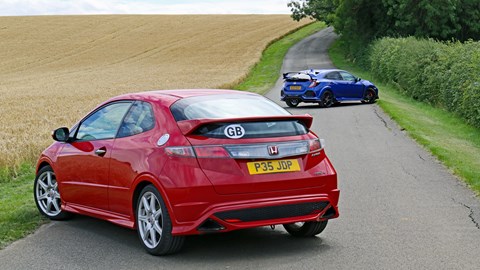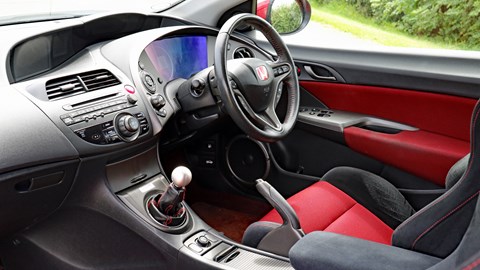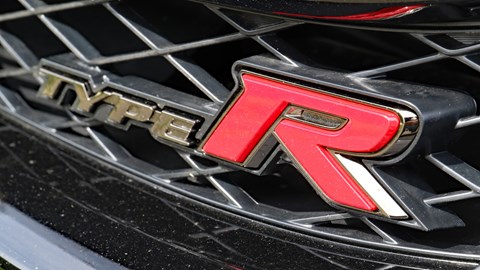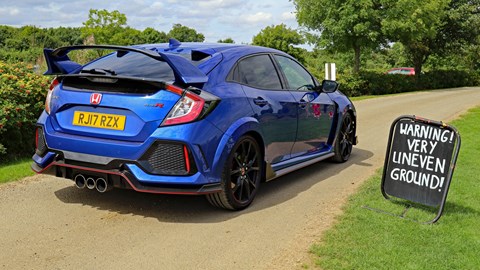► 2007 Civic Type R meets 2017 counterpart
► Serious progress made in the past decade
► Has Honda lost its soul in gaining 120bhp?
If you’re looking for a cool and unemotional comparison between two hot hatchbacks from the same company, you might wish to look away now.
The Type R franchise is long established, and has attracted such a huge fanboy following, that normal reviewing protocol occasionally goes out of the window, and we stroll into the good old-fashioned world of opinion, subjectivity and seat-of-the-pants snap judgments.

Although I’m old enough to know better, I’m an unashamed Type R fanboy. The red Honda Civic Type R GT in the pictures above is mine, and was recently bought for an embarrassingly small amount of money. The blue car is the 2017 model, recently vanquished by the Ford Focus RS in CAR’s group test, and is probably the best front-wheel-drive hot hatch money can buy right now.
In reality, it’s not a straight comparison – the old car is a tenth of the price, and is 120bhp down on the new car. It’s also probably not the absolute best Civic Type R – the previous-generation EP3 ‘breadvan’ is lighter, and more focused dynamically. But it’s still true to Honda’s naturally aspirated Type-R heritage, sky-high 8500rpm redline and old-school control inputs.
Click here to read CAR’s full review of the 2017 Honda Civic Type R
Tell me more about the older FN2 Type R?
Launched in 2007, the FN2-generation Euro-only Honda Civic Type-R combined the brilliant 2.0-litre VTEC K20A engine with famously spaceship-like styling. With the benefit of a decade’s worth of maturing, it looks taut and modern – and unlike its replacement, not awkwardly overstyled. Only the slim headlamps stop it looking like a car born in 2017.

Many would say that with a Type R, you’re buying an amazing engine first, and it doesn’t matter all that much what its wrapping looks like. I’d agree. With 198bhp developed at a supercar-like 7800rpm, the VTEC was this car’s crowning glory. Even 10 years ago, this focus on natural aspiration swam against the turbocharged flow of the rest of the hot hatch pack.
Under the skin, the FN2 was a retrograde step back from the EP3 breadvan. How so? The rear suspension moved from a multi-link independent set-up in the older car to a more conventional beam axle. It weighed in at 1190kg versus 1310kg for the newer car – and given there’s no appreciable power difference between the two, you can easily write the performance script.
Click here to read CAR’s original review of the 2007 Honda Civic Type R
How does the 2007 Honda Civic Type R drive?
As a member of 2007’s hot hatch front pack, the FN2 isn’t exactly slow. Maximum speed is 146mph, and the 0-60mph time is 6.6 seconds. It might have been a nadge slower than the car it replaced, but as an overall driving experience, it’s a lot more refined. Okay, so its six-speeder is geared like a sprint racer, with top gear pulling slightly over 20mph per 1000rpm, but Honda’s 2.0-litre is so smooth, so happy to rev, that it doesn’t feel at all frenetic at motorway speeds. If anything it might be a little too refined.
Too civilised to deliver its hot hatch brief? Dynamically, no. Its on-paper figures don’t tell the full story. Unless you’re completely on it, and prepared to rev it into the eights on a regular basis, it never really feels quick. And that’s because the transition from off- to on-VTEC is quite marked – it howls like a hard-edged 1990s BTCC racer in the upper rev band, but sounds quite flat when out of it. And that’s why so many CTR critics moan about its lack of torque. In reality, there’s plenty. But it’s far more apparent, and interesting, in the VTEC zone.

Aside from its lack of drama at anything less than nine-tenths, it’s disarmingly entertaining to drive, and a reminder of how much heft cars have gained in the past decade. The steering is hyper-sensitive, leading to sharp, almost aggressive turn-in, which is perfect for pushing on away from A-roads. What was described as a super-hard ride when new is now surprisingly well-damped and (almost) compliant – the main let-down is a disappointingly truculent gearchange.
How does the 2017 Civic Type R compare?
The new car follows the FN2 in that it’s been designed to stand out from the herd. It’s a striking-looking car, and far from handsome. In fact, it’s as far from cohesive as you could possibly imagine – the unhappy result of the brief for a ‘world car’, that needs to suit the tastes of the Americas, Europe and Asia. In reality, it probably doesn’t have a happy home anywhere. However, like the 2007 car, the questionable set of clothes hide a great engine.
And what an engine it is. With 320bhp, this is a fast car. Again, forget the on-paper figures, which would suggest these two cars aren’t that far apart in performance. They are. The 2017 car sprints from 0-62mph in 5.7sec and tops out at 169mph, but in any given situation, the old car wouldn’t see which way this went. Because Honda bowed to reality and turbocharged the CTR, its performance is much more readily accessible – you’re rarely waiting for boost to build or revs to rise. It just goes, and goes hard.

Absurdly hard, actually. Yet despite being probably too quick for UK roads, it never feels anything less than composed – so much so that in the pursuit of Ford Focus RS-chasing performance, it’s lost some of the feel and communication of the 2007 car. We’ll say the same about the engine note, which after the high-rev howl of the naturally aspirated version is little more than an angry drone. There’s not even any turbo whistle to amuse. Shame, because otherwise it’s a brilliant modern hot hatch.
So, the new car is loads better then?
The 2017 car is on a different planet to the 2007 CTR – in so much as it’s faster, more composed, easier to drive, and will no doubt use far less fuel. And yet, because the earlier car comes with its unique soundtrack, it feels the more special – more Honda – car of the pair.
If you’re a Type R fanboy, there’s enough spirit in the new car to satisfy you and dissuade you from changing sides and buying a Focus RS. But in gaining a turbo, I’d say it’s difficult not to conclude that in producing the best front-wheel drive hot hatch money can buy, a little bit of Honda’s hardcore Type R soul has been lost in the process.
Driving the classics: Honda’s Type R icons